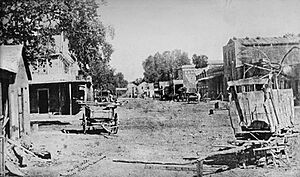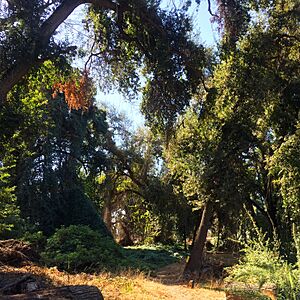History of Visalia, California facts for kids
Visalia, California, often called Four Creeks in the 1850s, is the oldest continuously settled inland European town between Stockton and Los Angeles. It played a big part in the American settlement of the San Joaquin Valley. Visalia was the main city for Old Tulare County, which was a huge area. This area included most of what are now Fresno, Kings, and Kern counties.
Contents
History of Visalia
Early Conflicts and Settlements
The Spanish didn't want to settle in this area because of the weather and what they saw as danger from the local Native American people. When European trappers, traders, explorers, miners, and settlers arrived, they changed the way of life for the native Yokuts people. The Europeans brought a different culture and diseases that the Yokuts had no protection against.
After gold was found in California in 1848, many settlers came into the San Joaquin Valley. They tried to push the Yokuts off their land. Between 1851 and 1854, a lot of money was spent by the state of California on military actions against Native Americans. Because of 18 treaties that were never officially approved, the Yokuts were moved from their lands. A reservation system was later set up for them. A few groups of Yokuts still live in the area today on rancherias and reservations.
When California became a state in 1850, Tulare County didn't exist yet. The land that is now Tulare County was part of the very large Mariposa County. The area was called Four Creeks because of the many rivers and creeks flowing from the Sierra Nevada Mountains. All this water created a large swampy area with a beautiful oak forest. This forest was a nice place in an otherwise dry region.
The first Anglo-American settler to live here permanently was probably Loomis St. John. He built a cabin on what is now called the St. John's River (California). In 1849, two young bear hunters from Texas, Nathaniel Vise and Gilbert Dean, came to the Four Creeks area.
In December 1850, a man named John Woods arrived with thirteen other men. Woods built a cabin near the Kaweah River. The Kawia Yokuts, led by Francisco, told the settlers to leave. When the settlers didn't leave, a conflict happened on December 13, and several settlers were killed. When General Patten arrived in 1851 to investigate, he built a fort near the Woods cabin. That same year, Nathaniel Vise returned and settled near where Visalia is today.
Settlers asked the state government to create a new county. On July 10, 1852, Tulare County was officially formed. Nathaniel Vise helped survey the new settlement. In November 1852, he wrote that the town had about 60-80 people. He believed it would become the county seat of Tulare. In 1853, Visalia became the county seat. At that time, Tulare County was huge, covering parts of Madera, Fresno, Kings, and Kern counties. Visalia was named after Visalia, Kentucky, where Nathaniel Vise's family came from.
Early records show that a school and a Methodist Church were built in Visalia in the same year. The next year, a grist mill (for grinding grain) and a general store were built. Visalia was once known as a "capital" for the "buckaroos" or vaqueros, who were California cowboys.
The Luxilis occidentalis Fish
The fish called Luxilis occidentalis was only known to live in Four Creeks and Poso Creek in Kern County. Dr. A.L. Heerman found it here in 1855.
Gold Rush and City Growth
In 1858, Visalia became a stop on John Butterfield's Overland Stage route. This route went from St. Louis to San Francisco. You can find a plaque marking this spot at 116 East Main Street. Some people who lived in Visalia at the time caused trouble for the stagecoach and its passengers. Many saloons and hotels opened near the stage stop downtown, and business was busy, though sometimes risky.
When the telegraph arrived in 1860, it brought news of the Civil War. During the Civil War, many people in Visalia had different opinions. Some supported the North, and others supported the South. These groups lived together, but it was difficult. Local officials couldn't solve the problems, so the government stopped a local newspaper, the Equal Rights Expositor, because it supported the South.
On June 24, 1862, a military camp called Camp Babbitt was set up about a mile from central Visalia. It was built by two companies of the 2nd California Cavalry. Camp Babbitt helped keep order and was a key base during the Owens Valley Indian War of 1862–1863. It was closed in 1866.
Visalia officially became a city during the Civil War years. It was incorporated again in 1874. This is when the city set up a council and a mayor, a system that is still used today.
Population Growth
| Year | Population |
|---|---|
| 1920 | 5,753 |
| 1930 | 7,263 |
| 1940 | 8,904 |
| 1950 | 11,709 |
| 1960 | 15,791 |
| 1970 | 27,268 |
| 1980 | 49,729 |
| 1990 | 75,636 |
| 2000 | 91,565 |
| 2010 | 124,442 |
Visalia's Oak Tree Tradition
For almost 100 years, Visalia has loved and cared for its oak trees. The city's neighborhoods are lined with these beautiful trees, showing that early leaders planned ahead. When Visalia was founded in 1852, it was in the middle of California's largest valley oak forest. These oak trees grew in the rich soil of the Kaweah River delta and covered an area of about 400 square miles (1,036 square kilometers).
As Visalia grew, more trees were cut down for firewood and to make space for new farms. Fewer trees remained. In the 1890s, people in Visalia realized that the oak tree was a symbol of their community. They decided to protect it. In 1909, community leaders suggested that Tulare County accept 100 acres (0.4 square kilometers) of oak trees on Mooney Ranch. They wanted to save this land as a park forever. Mooney Grove Park is still one of the largest valley oak forests in California.
In 1922, local groups started the first tree planting program. They planted the oak trees that now line Highway 198. In 1971, the city passed a rule that you need a permit to remove an oak tree. In 1974, rules for taking care of and protecting the trees were added. If you remove a Valley oak tree without a permit, you could face a $1,000 fine.
The End of the Trail Statue
Visalia was home to the original The End of the Trail statue by James Earle Fraser. It also had its partner statue, The Pioneer by Solon Borglum. These statues were in Visalia from 1920 to 1968. The city got them when San Francisco officials decided to get rid of them. San Francisco didn't have a place to display them after the 1915 Panama–Pacific International Exposition ended.
Today, the original The End of the Trail statue is at the National Cowboy & Western Museum in Oklahoma City. Before it was moved permanently, a life-size bronze copy was made. This copy was placed near the same spot in Mooney Grove Park where the original had stood for 48 years. The The Pioneer statue was in very poor condition. It was damaged in an earthquake in 1980 and remains in pieces in the Visalia area.




